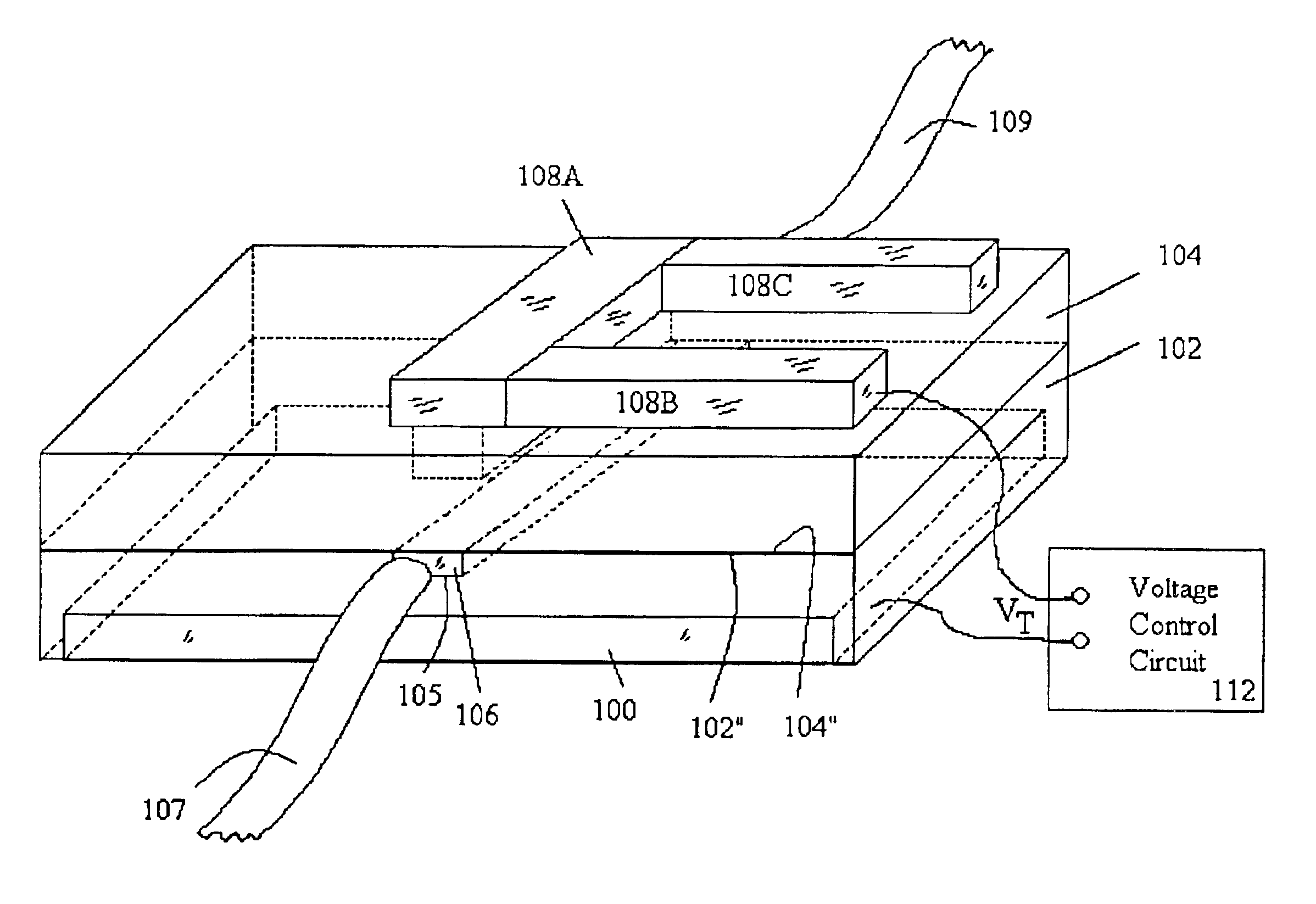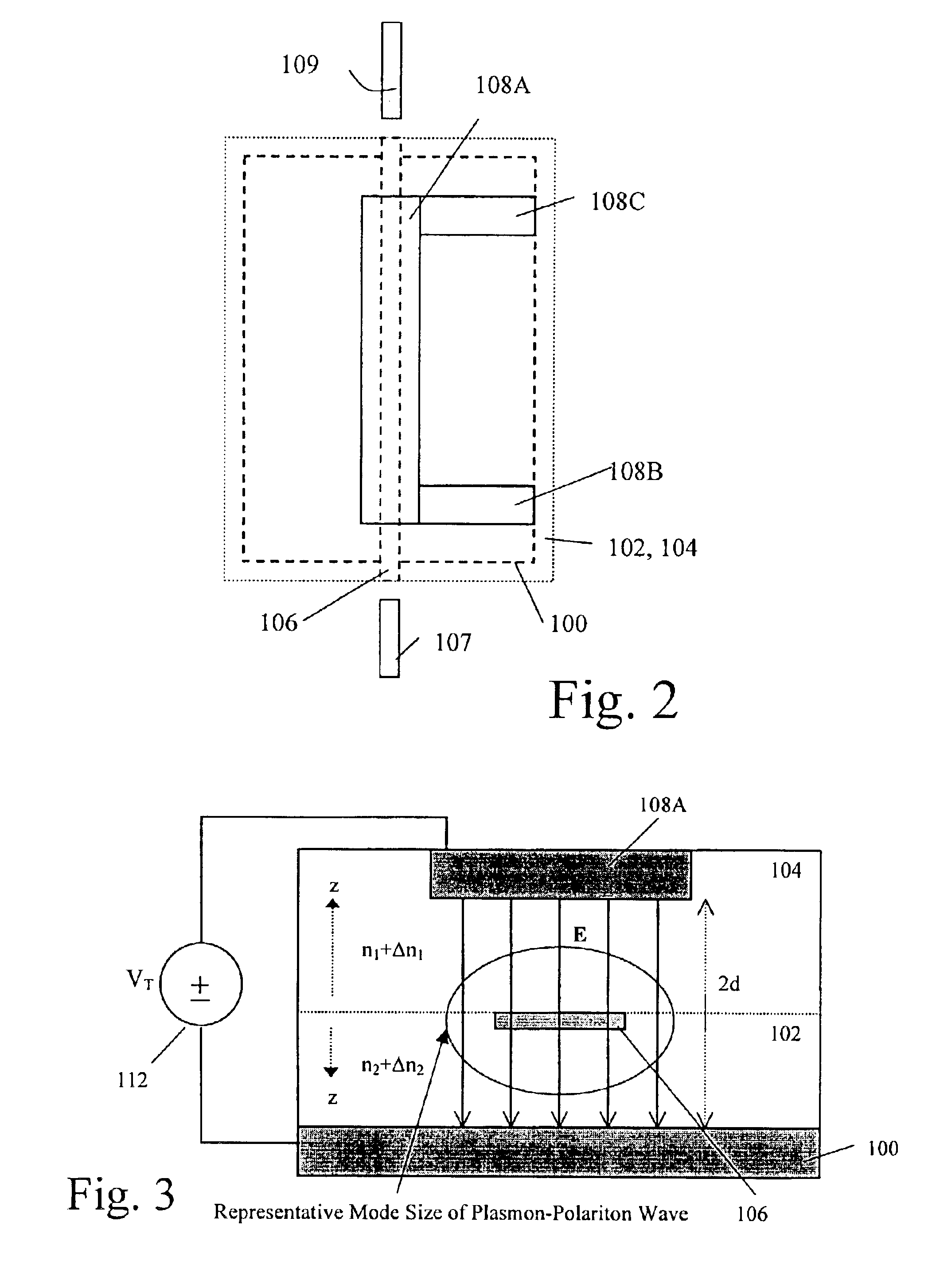Electro-optic modulators
a modulator and optical technology, applied in the field of modulation or variable attenuation of optical radiation, can solve the problems of modulation device disadvantageously limited optical bandwidth, inability to readily couple input and output waveguides, and light intensity modulation exiting dielectric waveguides
- Summary
- Abstract
- Description
- Claims
- Application Information
AI Technical Summary
Benefits of technology
Problems solved by technology
Method used
Image
Examples
first embodiment
[0039]the invention, the modulator illustrated in FIGS. 1, 2 and 3, comprises a die formed by two wafer portions of electro-optic material 102 and 104 having respective opposed flat surfaces 102″ and 104″ wafer-bonded together. A thin metal waveguide strip 106 deposited in a trench 105 formed (e.g. etched) in the surface 102″ extends the length of the die. Opposite ends of strip 106 are coupled to input and output waveguides 107 and 109, e.g., optical fiber waveguides, waveguides in an integrated optics device, or other plasmon polariton waveguides. The input waveguide is arranged such that the substantially TM polarized plasmon-polariton wave is excited efficiently. For example, the waveguide 107 could be a polarization-maintaining fiber connecting a polarized light source to the strip 106 with appropriate orientation. Alternatively, the input waveguide 107 could be the output plasmon-polariton waveguide of the external cavity laser disclosed in copending U.S. Provisional patent ap...
second embodiment
[0064]Because the strip 106 is a conductor, it too can be used as an electrode. Thus, FIGS. 6, 7 and 8 illustrate a second embodiment in which the operating voltage is applied between strip 106 and external electrodes 100a and 108 on the outermost surface of the electro-optic wafer portions 102 and 104, respectively. A plurality of optically non-invasive branch connector elements 114, similar in width and thickness to waveguide strip 106, spaced at intervals along the length of the waveguide strip 106 extend laterally from one side of the waveguide strip 106 to a parallel via 116 which is filled and capped with an electrode pad 118 so that electrical contact can be made to the waveguide 106 from the top of the modulator die. It should be noted that electrode pad 118 does not overlie the strip 106, and is positioned sufficiently far away from the strip 106 so as to not interact with the plasmon-polariton wave propagating along the strip 106.
[0065]FIG. 7 shows connecting electrodes 12...
fourth embodiment
[0086]A fourth embodiment, which makes use of another class of linear electro-optic materials, will now be described with reference to FIGS. 10, 11 and 12. In this class of linear electro-optic materials, especially those from the symmetry group {overscore (4)}2m namely KDP (KH2PO4), DKDP or KD*P (KD2PO4), ADP ((NH4)H2PO4), AD*P ((NH4)D2PO4) and also including others, where the crystal wafer is cut so that the normal to its largest face is at a 45 degree angle to the x and y axes of the crystal and the z axis is in the plane of this surface, an applied electric field parallel to the z-axis will cause a change in the index of refraction Δn normal to the surface given by Δ n=-12n3rE
where n is the nominal zero field index of refraction of the electro-optic material, r is the electro-optic coefficient and E is the applied electric field. The effect is linear with E and the sign of the change in index of refraction depends on the sign of the applied field.
[0087]When using these parti...
PUM
 Login to View More
Login to View More Abstract
Description
Claims
Application Information
 Login to View More
Login to View More - R&D
- Intellectual Property
- Life Sciences
- Materials
- Tech Scout
- Unparalleled Data Quality
- Higher Quality Content
- 60% Fewer Hallucinations
Browse by: Latest US Patents, China's latest patents, Technical Efficacy Thesaurus, Application Domain, Technology Topic, Popular Technical Reports.
© 2025 PatSnap. All rights reserved.Legal|Privacy policy|Modern Slavery Act Transparency Statement|Sitemap|About US| Contact US: help@patsnap.com



